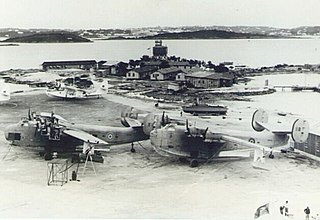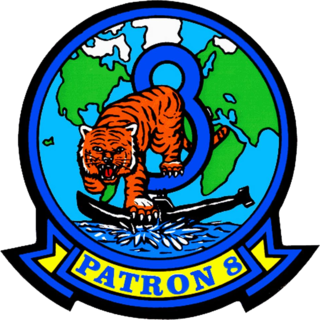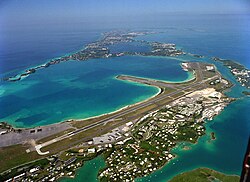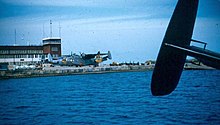
While Bermuda technically remains the responsibility of the government of the United Kingdom, rather than of the local Bermudian Government, the island still maintains a militia for the purpose of defence.

The Royal Danish Navy is the sea-based branch of the Danish Defence force. The RDN is mainly responsible for maritime defence and maintaining the sovereignty of Danish territorial waters. Other tasks include surveillance, search and rescue, icebreaking, oil spill recovery and prevention as well as contributions to international tasks and forces.

L.F. Wade International Airport, formerly named Bermuda International Airport, is the sole airport serving the British overseas territory of Bermuda in the North Atlantic Ocean. It is located in the parish of St. George's and is 6 NM northeast of Bermuda's capital, Hamilton. In 2016, L.F. Wade International Airport handled about 402,925 passengers, up 5.6% from 2006. It has one passenger terminal, one cargo terminal, eight aircraft stands and can support all aircraft sizes up to and including the Airbus A380. Currently, eight passenger or cargo airlines operate seasonal or year-round scheduled services to Bermuda Airport from Canada, the United Kingdom, and the United States.
The destroyers-for-bases deal was an agreement between the United States and the United Kingdom on September 2, 1940, according to which 50 Caldwell, Wickes, and Clemson class US Navy destroyers were transferred to the Royal Navy from the US Navy in exchange for land rights on British possessions.

Kindley Air Force Base was a United States Air Force base in Bermuda from 1948–1970, having been operated from 1943 to 1948 by the United States Army Air Forces as Kindley Field.

Boaz Island, formerly known as Gate's Island or Yates Island, is one of the six main islands of Bermuda. It is part of a chain of islands in the west of the country that make up Sandys Parish, lying between the larger Ireland Island and Watford Island, with which it has been joined by a man-made isthmus. South of Watford Island is Somerset Island. Boaz and Watford are connected to Somerset by Watford Bridge, and to Ireland by Gray's Bridge. Watford's east coast forms part of the edge of the Great Sound. The western end of the channel between Boaz and Watford was blocked by the isthmus, creating a camber that opens to the Great Sound. Boaz and Watford Islands were parts of the Royal Naval base, which included the HM Dockyard on Ireland Island.

The Royal Air Force (RAF) operated from two locations in the Imperial fortress colony of Bermuda during the Second World War. Bermuda's location had made it an important naval station since US independence, and, with the advent of the aeroplane, had made it as important to trans-Atlantic aviation in the decades before the Jet Age. The limited, hilly land mass had prevented the construction of an airfield, but, with most large airliners in the 1930s being flying boats, this was not initially a limitation.

USS Gannet (AM-41) was an Lapwing-class minesweeper built for the United States Navy near the end of World War I.

The Airport Security Police is the police force of the Bermuda International Airport.

The Northeast Air Command (NEAC) was a short-lived organization in the United States Air Force tasked with the operation and defense of air bases in Greenland, Labrador and Newfoundland. It was formed in 1950 from the facilities of the United States established during World War II in Northeast Canada, Newfoundland and Greenland. It was discontinued in 1957.

Patrol Squadron Eight (VP-8) is a U.S. Navy land-based patrol squadron stationed at Naval Air Station Jacksonville, Florida (USA). VP-8 is tasked to undertake maritime patrol, anti-submarine warfare (ASW), and intelligence, surveillance and reconnaissance (ISR) missions. The Squadron is equipped with the Boeing P-8A Poseidon.

The United States Naval Station Whites Island was a United States Navy (USN) facility located on White's Island in Hamilton Harbour, in the British Colony of Bermuda, 640 miles off the coast of North Carolina.

The Bermuda Base Command was a command of the United States Army, established to defend the British Colony of Bermuda, located 640 miles off Cape Hatteras, North Carolina. It was created in April 1941 when United States Army troops were sent to the island.

VP-49 was a long-lived Patrol Squadron of the U.S. Navy, having held that designation for 45 years from 1948 to 1994. Its nickname was the Woodpeckers from 1973 to 1994. It was established as VP-19 on 1 February 1944, redesignated Patrol Bombing Squadron VPB-19 on 1 October 1944, redesignated VP-19 on 15 May 1946, redesignated Medium Patrol Squadron (Seaplane) VP-MS-9 on 15 November 1946, redesignated VP-49 on 1 September 1948 and disestablished 1 March 1994.
773 Naval Air Squadron was a Naval Air Squadron of the Royal Navy's Fleet Air Arm.

HMS Castle Harbour was a civilian harbour vessel of 730 tons that was taken-up from trade (TUFT) during the Second World War by the Royal Naval Dockyard in Bermuda for use by the Royal Naval Examination Service and later armed and commissioned as a warship, providing harbour defence from submarines.

US Naval Advance Bases were built globally by the United States Navy during World War II to support and project U.S. naval operations world-wide. A few were built on allied soil, but most were captured enemy facilities or completely new. Advance bases provided the fleet with support to keep ships tactically available with repair and supply depots of facilities, rather than return them to continental United States. Before Japan declared war on the United States the US Navy had a single fleet sized advanced base in the Territory of Hawaii. It was Naval Station Pearl Harbor. During the war the US Navy Seabees built over 400 advance bases categorized by size. Naval bases were either Lions or Cubs while airfields were either Oaks or Acorns. Lions and Oaks were major facilities while Cubs and Acorns were minor. PT Boats typically would get a Cub and airfields with single runways were Acorns. The larger bases could do refueling and overhaul; loading of troopship and cargo ships; and preparing amphibious assault ships. Some became major repair depots. The Seabees developed auxiliary floating drydocks were able to repair battle damage and do regular maintenance in the field saving ships trans-pacific trips for repair. A few bases also were developed to be R and R for all U.S. personnel. Most Advance Bases were built by the US Navy's Seabees in Naval Construction Battalions (CBs). At the start of the war some civilian contractor were employed in construction. The Seabees in World War II built most of the airfields used by the United States Army Air Forces and United States Marine Corps, as they had the ships and cranes needed to transport the vast amount of equipment needed at the advance bases. The US Army and United States Coast Guard also operated out of many of these facilities. Seabees could build new or repair damaged runways, and with advancements in heavy bomber technology lengthen runways as needed. A few Naval Advance Bases were built for the Korean War and Vietnam War.

Scaur Hill Fort, also called Scaur Hill Lines and Somerset Lines, is a fortified position erected in the 1870s at Scaur Hill, on Somerset Island, in Sandys Parish, the westernmost parish of the Imperial fortress colony of Bermuda.

RNAS Bermuda was a Royal Naval Air Station in the Royal Naval Dockyard on Ireland Island until 1939, then Boaz Island, Bermuda. Bermuda became the primary base for the North America and West Indies Station of the Royal Navy in the North-West Atlantic following American independence. It was the location of a dockyard, an Admiralty House, and the base of a naval squadron.

Naval Base Darwin was a United States Navy base built during World War II at Darwin, Northern Territory, Australia. The first US operations at Darwin was Naval mine depot, built to supply Australia with mines to support the Pacific War. As the US Navy expanded in the Island hopping campaign, Naval Base Darwin expanded to include a Port Darwin submarine base, PT boat Bases, and other facilities. US Navy operations started in 1942 and ended after the war in 1945.
























